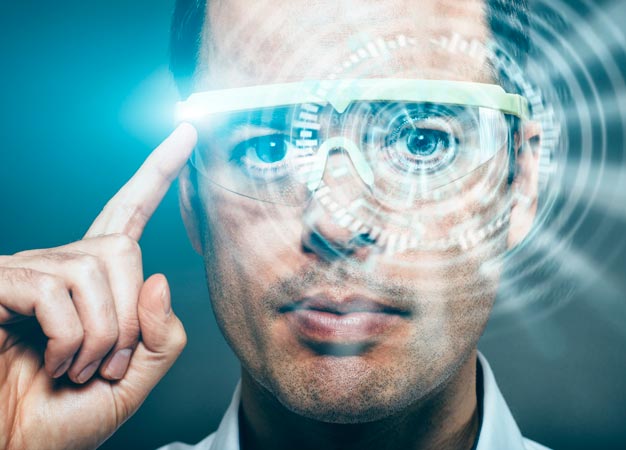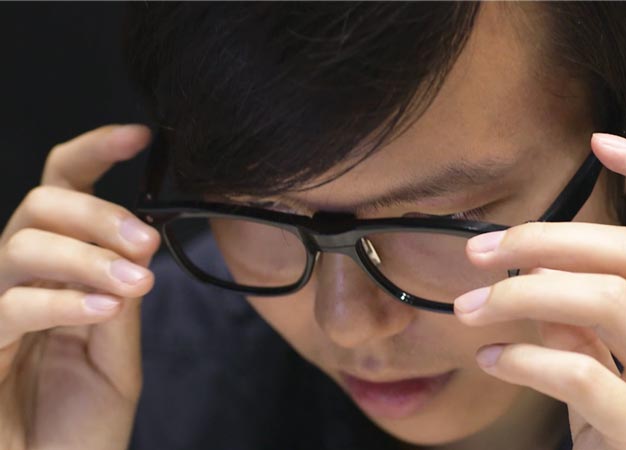Researchers are creating smart eyewear that will measure your reading habits and will even tell you how much you understood
Published online 29 June 2017

Future virtual reality devices are likely to be fitted with eye-tracking technology.
© mikkelwilliam/Getty
For the foreseeable future, making tech more intuitive will be about analyzing eye gaze and the delicate muscles and skin around your eyes, says Kai Kunze, a researcher at Keio University. "Eyes can tell you everything from where you're focused to your level of expertise in a topic," explains Kunze, a German-born, Tokyo-based expert in wearable computing, cognition-aware computing, and smart eyewear. "If you understand something well, for example, your gaze will usually flow nicely and you won't fixate on unfamiliar words for very long."
Kunze's doctoral students at Keio's Graduate School of Media Design are tweaking wearable headsets in ways that could change our everyday lives. One project is looking at how to allow the motion-sick to navigate virtual environments nausea-free while standing still ― a key problem holding virtual reality (VR) technology back. Another is seeking to harness your natural squint to zoom in on hard-to-see objects.
Eye-interpreting equipment, Kunze says, is more advanced than other technologies and will be the first cab off the rank in the race toward VR headsets and wearable computing devices, such as Google Glass. "There's technology that can measure brain activity, but it's too hard to process that information in real time. For real-time feedback, eyes can provide a lot more information much faster."
"We've already seen a couple of start-ups and kick-starter campaigns doing similar work. Three years ago, we implemented our own eye tracking in VR headsets because nobody had done it before. I suspect the next Oculus or Second Life head-mounted displays will come with eye tracking. It's relatively cheap to implement, and you gain a lot from it in the VR headset space."
Reading glasses that measure fatigue
Japan, says Kunze, is an amazing place to work on this type of tech because of the low resistance to incorporating new technologies into daily life. Some of his innovations have already hit the market.

Glasses being retailed by the Japanese eyewear company J!NS can monitor fatigue and concentration levels.
© 2017 Keio University
For example, prescription glasses from Japanese eyewear company J!NS look like retro horn-rimmed glasses, but use electrooculography eye tracking to give wearers all sorts of information about their physical and mental state (see image). Using installable apps, the glasses can alert tired drivers and monitor concentration levels at work using feedback from blinks and eye movement.
Kunze, who was a consultant in the design, says that electrooculography is a promising form of eye tracking because it is computationally light. It involves measuring changes in electric fields caused by eye movement using electrodes positioned on the skin around the eyes, which can be inserted into the nose pads and bridges of conventional glasses. "Eyes are basically like a dipole," says Kunze. "The electric charge the sensors detect varies as you move your eyes toward or away from a sensor."
J!NS commercially released these glasses in 2015. In many respects, they echo the roll out of physical activity trackers ― like Fitbits for the mind. However, since more than 80 per cent of sensory information comes to humans via the head, Kunze points out that these devices are green pastures for researchers.
Are you in the right headspace to read that report?
Your glasses could soon reveal your intellectual habits ― good and bad ― doubling as a fitness tracker for your brain.
For example, research by Kunze and colleagues in Germany and Osaka Prefecture University has provided a basic proof of concept of Kunze's Wordometer, which uses the electrooculography technology in J!NS glasses to count the number of words the wearer reads in a day.
More-subtle mental processes such as cognitive load, attention distribution, and stress require a lot of psychological research, and so Kunze and his colleagues have been measuring facial temperature patterns and electrodermal activity (EDA). EDA technology uses spectacle touch points in a similar way to electrooculography, but measures sweat gland permeability, changes in skin resistance to a small electrical current, or the differences in the electrical potential between different parts of the skin. The advantage of EDA is there is a wealth of information on what these measurements can tell you about your psychological state ― EDA has been used in psychological research since Carl Jung used it to study psychological arousal in the early 1900s.
In short, says Kunze, smart eyewear could very soon tell you whether it's time to read that difficult report or just go for a walk.